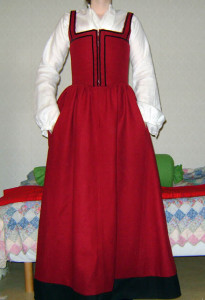A Fistful of Probates
Probate Inventories are inventories taken at the time of someone’s death, and are meant to catalog the value of everything they own in order to come up with a true value for the person’s assets–useful when calculating estate taxes, etc.
A probate inventory usually progresses methodically through the person’s house, listing the worth of their furniture, kitchen equipment, farming equipment, etc., etc. In some cases, the clothing for a person is summed up in a succinct “His Apparell: 1L”. Sometimes we’re luckier, and the inventory contains a more detailed listing of the person’s clothing, with a value given for each item.
Even so, probate inventories are rarely an accurate glimpse into a person’s possessions or belongings. Items always disappeared between a person’s death and an inventory-taking, and clothing was a notoriously portable form of wealth.
In the book Wills and Inventories from the Registry at Durham, Probate Inventories for a number of merchants are listed–including fabric merchants. Drapers, Mercers, and Haberdashers. The contents of their shops are given in detail, with prices for all of the fabrics and small wares they contained. This is a valuable snapshot into the life of tailors and others working with cloth–what fabrics did they buy, of what colors, and how much did these fabrics cost?
I loaded a number of probate inventories into DressDB from Durham Wills and Inventories today. Some were for merchants, others for people with particularly detailed wardrobes. All are of interest and use to the textile and clothing historian.
